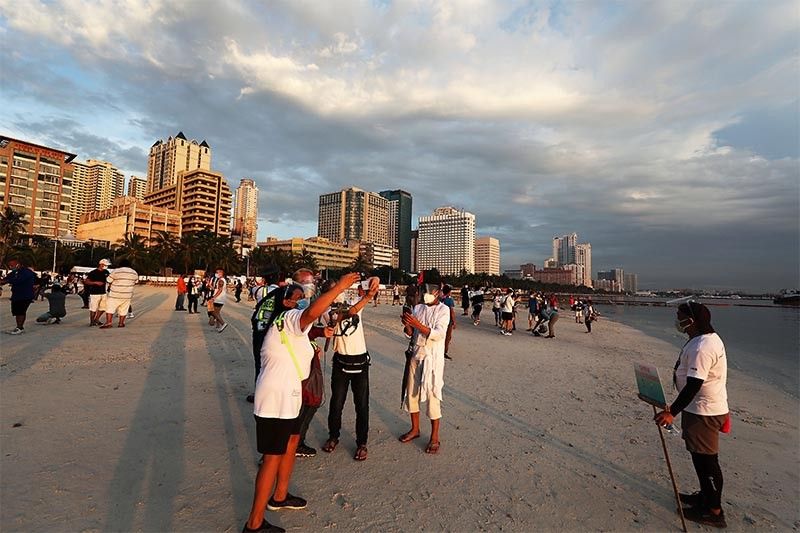'Manila Bay Sands' a costly effort that won't solve Manila Bay's problems — marine scientists

MANILA, Philippines — Overlaying a small portion of Manila Bay's shoreline with crushed dolomite rocks is an expensive and temporary effort that will not help solve the bay’s environmental problems, the University of the Philippines Marine Science Institute said Wednesday.
Dolomite grains were laid as a topping to the naturally gray coastline of a portion of the Manila Baywalk as part of a P389-million “beach nourishment” project. This project is part of the government’s rehabilitation program for the degraded bay, officials said.
"There are no shortcuts to a cleaner environment. The use of crushed dolomite sand will not help solve the environmental problems in Manila Bay. At most, it is a beautification effort that is costly and temporary," the UP MSI said.
Threat of erosion
Among the environmental problems that beset Manila Bay are poor water quality due to poor waste management and erosion, which is influenced by wind direction, wave action and tidal fluctuation
The Department of the Environment and Natural Resources earlier said that a “nourished” beach will prevent erosion by “dissipating wave energy and having a balanced sediment budget.”
But the addition of crushed dolomite rocks "cannot serve to anchor the loss of beach sand nor serve as replacement for eroded sediments," the UP MSI said.
It explained that beach nourishment projects are not "one-shot deals," especially for continuously eroding shorelines aggravated by excessive groundwater extraction and land subsidence.
"Dolomite sand grains will erode given the hydrodynamic conditions in coastal Metro Manila during storms. Even the breakwater off the baywalk area, elevated seas and larger waves during storms can penetrate and pound the baywalk area. Hence, continuously replacing the sand will be expensive and will not contribute to improving water quality in the bay," UP MSI said.
'Beach nourishment unnecessary'
The UP Institute of Environmental Science and Meteorology, in a separate statement, said that coastal erosion in the site where the dolomite sand was laid has already been addressed by installation of seawall and breakers, “making it unnecessary to implement beach nourishment.”
Both the UP MSI and UP IESM said that dolomite particles will be carried out to sea during storm surges and intense rainfall events.
The DENR earlier said that geotextile tubes were installed on the beach, which will act as a breakwater and will allow water to pass through while preventing the filling material from being washed away.
It is unclear whether this has already been done, but sandbags have been placed along the shoreline of the "white sand beach."
‘Environmentally damaging’
The DENR also said that crushed dolomite rocks will help neutralize the acidity of the water in Manila Bay.
But the UP MSI stressed that “such augmentation in the carbonate ion budget from dolomite addition is not a solution to the potential acidification happening in Manila Bay” because ocean acidification occurs on a much larger scale.
The UP IESM also said that the beach nourishment project will be “environmentally damaging” in the long run.
The institute added that the washing off of dolomite sand from the beach is similar to dumping foreign sediments, which can disturb plants and habitats of marine animals by potentially burying them, lowering the oxygen in the seawater and blocking their access to sunlight.
“These outcomes endanger the biodiversity of the area. The polluted waters discharging to Manila Bay are already causing the degradation of its marine environment. The addition of sediments only hastens its deterioration,” it said.
‘Long and arduous task’
The two UP institutes pointed out that the clean-up of Manila Bay will be a “long and arduous” task.
“We support efforts to restore the natural environmental integrity of the bay by well-considered and science informed efforts in sewage treatment, waste management, providing informal settlers with housing and sewered toilets, mangrove rehabilitation and tourism management,” UP IESM said.
The UP MSI also said there is a need for a massive restoration of watersheds and monitoring of emerging organic pollutants such as plastic component.
“The task of cleaning and restoring Manila Bay may be daunting but it needs to be done for future generations of Filipinos to benefit from its many uses,” it said.
- Latest
- Trending






























